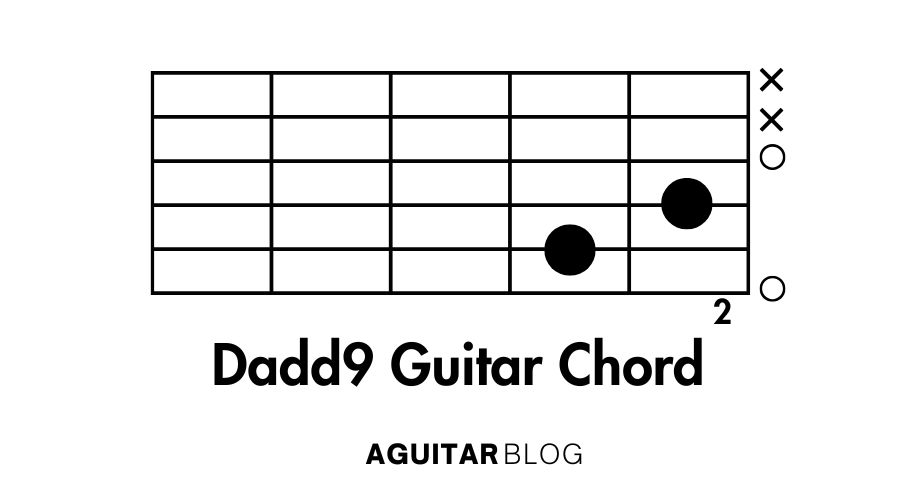The Dadd9 guitar chord (D added ninth) is a bright and shimmering chord that adds extra color to a standard D major chord. The addition of the ninth note (E) creates a more open, airy sound, making it popular in folk, pop, and rock music. In this guide, we’ll explore what the Dadd9 chord is, how to play it, common mistakes to avoid, and tips for improving your playing.
1. What is a Dadd9 Guitar Chord?
The Dadd9 chord is essentially a D major chord with an added ninth note. It consists of four notes: the root (D), the major third (F#), the perfect fifth (A), and the ninth (E). The ninth note adds a sparkling quality to the chord without altering the underlying D major sound.
Dadd9 Chord Formula:
- Root (D)
- Major third (F#)
- Perfect fifth (A)
- Added ninth (E)
This chord gives you the richness of a D major chord with an extra layer of brightness and complexity.
2. How to Play the Dadd9 Guitar Chord

There are several ways to play the Dadd9 chord depending on your style and preference:
Dadd9 Open Position (Easy Version):
- Mute the 5th (A) and 6th (E) strings by either not playing them or resting your thumb lightly on them.
- Leave the D string open for the D note (root).
- Place your index finger on the 2nd fret of the G string (3rd string) for the A note (fifth).
- Place your middle finger on the 3rd fret of the B string (2nd string) for the D note (root).
- Leave the high E string open for the E note (ninth).
This version of the Dadd9 chord is easy to play and sounds beautiful in open position, making it perfect for beginners and intermediate players.
Dadd9 Barre Chord (5th Fret):
- Barre your index finger across the 5th fret, covering all six strings.
- Place your middle finger on the 6th fret of the G string (3rd string).
- Place your ring finger on the 7th fret of the D string (4th string).
- Strum from the A string down, playing five strings.
This barre chord voicing gives the Dadd9 a fuller, more resonant sound and is often used in more advanced playing styles.
Strumming Tips:
- For the open position, avoid strumming the low E string to keep the chord clean.
- Focus on a light, even strum to bring out the brightness of the added ninth note.
3. Video Tutorial
For a visual demonstration of how to play the Dadd9 chord, you can watch this Video Tutorial on the Dadd9 Chord, where finger placement and strumming techniques are clearly shown.
4. Common Mistakes and Tips for Playing the Dadd9 Guitar Chord
Common Mistakes:
- Strumming the wrong strings: In the open position, be careful not to strum the low E string, which isn’t part of the chord.
- Muted strings: Ensure that each string rings clearly, especially in the barre chord version where all strings must be pressed firmly.
- Incorrect finger pressure: In barre chords, weak finger pressure can lead to buzzing or muted notes.
Tips for Playing the Dadd9 Chord:
- Check string clarity: Play each string individually to make sure all notes are ringing clearly.
- Finger strength: If playing the barre version, work on finger strength and dexterity to ensure smooth chord transitions.
- Transition practice: Practice transitioning between Dadd9 and other chords like D, G, and A for smoother playing.
5. Dadd9 Chord Variations
Here are a couple of common Dadd9 chord variations to try:
- Dadd9 (Root on 10th Fret):
- Move the D major shape up the neck to create a higher-pitched Dadd9, which adds a brighter, shimmering quality.
- Dadd9 (Power Chord Variation):
- Focus only on the root (D), fifth (A), and ninth (E) to create a simplified power chord version of Dadd9, great for rock or folk styles.
6. Chord Progressions and Songs Featuring the Dadd9 Guitar Chord
Common Chord Progressions:
- Dadd9 – G – A: A bright and open progression that works well in folk and pop songs.
- Dadd9 – Aadd9 – E: A sparkling progression that adds color to simple chord changes.
- Dadd9 – Em7 – G – A: A smooth and flowing progression that works beautifully in acoustic ballads and pop.
Songs Featuring the Dadd9 Chord:
- “Every Breath You Take” by The Police: Features the Dadd9 chord to create a sparkling, ethereal sound.
- “Good Riddance (Time of Your Life)” by Green Day: Uses the Dadd9 to add brightness and emotional depth to the song.
- “Sweet Child O’ Mine” by Guns N’ Roses: Includes Dadd9 in the intro, adding to the distinctive, melodic sound.
7. Tips for Practicing the Dadd9 Guitar Chord
- Slow transitions: Work on transitioning between Dadd9 and other major chords slowly at first to build muscle memory.
- Try fingerpicking: Use fingerpicking instead of strumming to highlight the individual notes of the Dadd9 chord, adding a delicate, nuanced sound.
- Experiment with dynamics: Play the Dadd9 chord softly and then with more intensity to explore its emotional range.
8. Related Chords to Dadd9 Guitar Chord
Here are some related chords that sound great with Dadd9:
- Aadd9: Another added ninth chord that pairs well with Dadd9 in folk and pop progressions.
- Gadd9: Similar in structure, this chord complements Dadd9 in bright, open chord progressions.
- Dsus2: A suspended chord that adds a bit of tension and works well with Dadd9.
The Dadd9 guitar chord is a beautiful, bright chord that can add depth and emotion to your music. Whether you’re playing folk, pop, or rock, this chord will bring a sparkling quality to your sound. Take your time to master its finger placement and transitions, and you’ll have a versatile tool for creating expressive music. Happy playing!